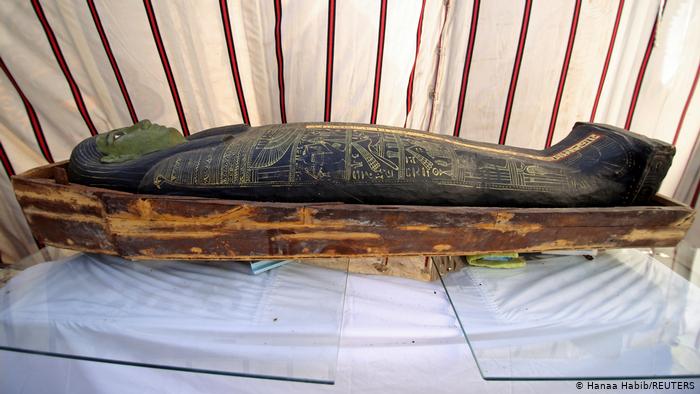
Sarcophagi were found down 22 burial shafts at depths of 10 meters to 12 meters (about 32 feet to 39 feet), Egypt’s Tourism and Antiquities Ministry announced Sunday.
Also unearthed were statues, stelae, toys, wooden boats and funerary masks.
The finds made by a team of archeologists included the “funerary temple of Queen Naert, the wife of King Teti,” as well as three brick warehouses, the ministry added.
‘Book of the Dead’
Former antiquities minister and famed Egyptologist Zahi Hawass told reporters at the vast Saqqara site south of Cairo that among the finds was a 4-meter-long Book-of-the-Dead papyrus.
Such texts were purported to guide the newly buried through the perceived underworld.
The finds date back to the Sixth Dynasty that ruled Egypt from 2323 BC until 2150 BC, he said. More than 50 wooden coffins dating back to the subsequent “New Kingdom,” between 1570 BC and 1069 BC, were also unveiled on Sunday.
The plans for the temple’s layout were also found, Hawass added.
“This is the first time that coffins dating back to 3,000 years have been found in the Saqqara region,” he said, referring to other recent finds.
Tourists frightened off
Saqqara is part of Egypt’s ancient capital of Memphis, which includes Giza and other pyramids, declared a UNESCO World Heritage site in the 1970s.
To rejuvenate its tourism sector, Egypt has promoted new finds in recent years to win back travelers put off by years of political turmoil that followed the 2011 uprising that toppled autocrat Hosni Mubarak.
Later this year, authorities plan to inaugurate a new museum — the Grand Egyptian Museum — at the Giza plateau.
More to come…
Excavations at Saqqara in recent years also focused on the step pyramid of Djoser, one of the earliest built in ancient Egypt.
Last November, antiquities minister Khaled al-Anani predicted that “Saqqara has yet to reveal all its contents.”
ipj/sms (AFP, AP, dpa)
SPECTACULAR ARCHAEOLOGICAL FINDS FROM ANCIENT EGYPT
59 sarcophagi in Saqqara
In October 2020, archaeologists discovered 59 coffins in the necropolis of Saqqara, a UNESCO World Heritage Site 30 kilometers (19 miles) south of the Egyptian capital, Cairo. Covered in intricate designs in vibrant colors, the sarcophagi had not been opened for more than 2,500 years and were extremely well preserved, just like the mummies they contained.
The ‘light bulbs’ of Dendera
Reliefs in the Ancient Egyptian temple complex of Dendera show bulb-shaped objects with “wire filaments” running through them. A fringe theory sees this as evidence that ancient Egyptians possessed electrical technology — perhaps even brought by aliens. Serious Egyptologists however view the carvings as representations of mythological symbols.

The Rosetta Stone
This stone tablet, discovered in the Nile Delta in 1799, has a text carved in Ancient Greek and one in Ancient Egyptian in two different scripts, Demotic and hieroglyphics. The inscriptions dating back to 196 BC praise the Egyptian king Ptolemy V. The Rosetta Stone famously contributed to deciphering Egyptian hieroglyphs in 1822.

Nefertiti’s bust
The bust of the legendary queen was created between 1353 and 1336 BC and found in 1912 during excavations made by the German Orient Society. Even though there is no inscription on the bust, its crown and similarity to other portraits allowed experts to identify it as a representation of Nefertiti. Except for one missing eye, the bust was exceptionally well preserved.

The temple of Abu Simbel
The temples at Abu Simbel were built in the 13th century BC. It was not until 1813 that the Swiss traveler Jean Louis Burckhardt discovered the Great Temple of Ramses II buried in the sand. In the 1960s, the newly created Lake Nasser threatened today’s World Heritage Site. The large Ramses Temple and the smaller Hathor Temple in memory of Nefertari had to be relocated.

Pyramid of Cheops
The Pyramid of Cheops, the oldest and largest of the three pyramids of Giza, was built from 2620 to 2500 BC. It was believed to have been explored from top to bottom — until a high-energy particle radiation scan in 2017 revealed a hidden cavity located above the large gallery and 30 meters (98 feet) long. Paths or tunnels do not lead into the secret chamber, and its purpose is still unclear.











